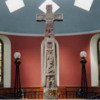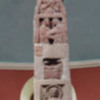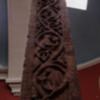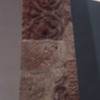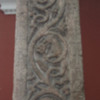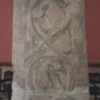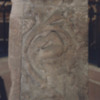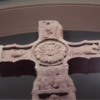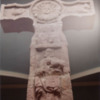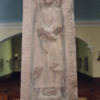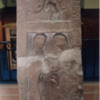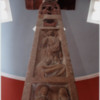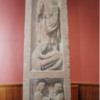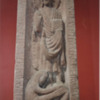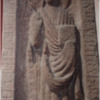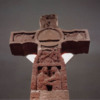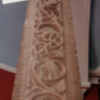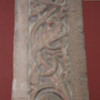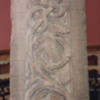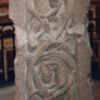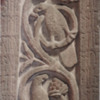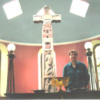The Ruthwell Cross
Title
The Ruthwell Cross
Subject
Archaeology
Description
Introduction
The Ruthwell Cross stands in a small church in the town of Ruthwell, just south of Dumfries, in south-west Scotland. The Cross is seventeen feet four inches tall and must sit in a well four feet deep to serve as the high cross for the church. "With the comparable cross at Bewcastle it is undoubtedly the most important sculptural survival from Anglo-Saxon Britain and arguably from early medieval Europe" (Cassidy 3). What makes the Cross so valuable as an artefact is its blend of elaborate ornamentation and inscriptions in both Latin letters and Anglo-Saxon runes; as well, the Cross preserves in those runes lines from a later Anglo-Saxon poem, "The Dream of the Rood." There is much to consider about the cross, and this web site can only serve as an introduction to an object (and a poem) about which volumes have been written.
Age
Scholars, focusing on particular aspects of the Cross, have argued for a variety of dates. Looking at particular aspects of the Cross (such as the runic inscriptions and vine-scrolls), especially in comparison to the Bewcastle Cross, has led some (like Rosemary Cramp) to argue for dates from the end of the seventh century to the middle of the eighth (MacLean 49-53). The linguistic evidence of the runic inscriptions encouraged R. I. Page to place the Cross anywhere from 650 to 850. Historians point out that since southern Scotland was clearly under Celtic control until the end of the seventh century, it is "unlikely that so conspicuously Anglian a monument was erected much before 682" (Mac Lean 68). Evidence drawn from examining the designs found in the Northumbrian monasteries of Jarrow and Monkwearmouth suggests a mid-eighth-century date. MacLean concludes that the Cross probably dates from AD 750 (at about the same time of the construction of the Bewcastle Cross).
Physical State
The Ruthwell Cross has had a painful history. It is not now what it originally was. As it was originally set up outside, certainly the weather played a part in the eroding of its physical shape (before, of course, the Cross was moved into the church building), but the real damage came in the seventeenth century when "efficient and dedicated iconoclasts" pulled the Cross over (Farrell 34, 39-40). The Cross fractured at the cross-arm (transom); the cross-head and arms broke into fragments; parts of the lower body were cut away.
In the eighteenth century, pieces of the Cross were moved into the church. In the early nineteenth century the process of reconstruction began under the direction of Dr. Duncan (priest at Ruthwell 1799-1843). But in the process, some mistakes were made. Due to some injudicious placements of pieces, gaps were created and subsequently filled in with mortar. Some figures, then, were "elongated." The result is an unpolished work. Also, the original transom was never found; one was thus constructed for the Cross (pictures show how sharp and less-weathered the cross-beam appears now). Obviously, this "interpreted" cross-beam cannot have the same images the original had and thus throws off the symbolic unity of the Cross. As well, the very top piece, which was found, was put on backwards; what faces south should face north.
Actually, the whole cross has been turned in its placement (for example, the South Face probably originally faced east); based on comparisons to the Bewcastle Cross, the panel that should be presented to the congregation should be Christ in Majesty; yet this panel faces North, away from the congregation and visible only if one walks around the altar to the back of the Cross (Farrell 36-7).
The Faces of the Cross
Each face of the Ruthwell Cross is intricately designed and inscribed. There seems to be a certain unity to the South and North faces; the North Face has images of Christ in Eucharistic form, while the South side emphasizes His human form. There is a balances of male and female images on the Cross; Saints Paul and Anthony are balanced by Mary and Martha, for example. The separate panel and faces can be understood individually, but they also interact with the opposing panels and faces; in fact, the Cross has its greatest impact when viewed personally, when the "reader" can walk around it and perceive the interaction of the panels. (Perhaps the Cross was part of the liturgy, as one could read the scripture verses aloud while looking at the panels.)
The South Face has a (later?) Crucifixion at the base (which would have been visible when the Cross stood by itself rather than within a well). Above it is the Annunciation (a lesson in accepting the will of God), then the healing of a man born blind (the healing power of God), then Mary Magdalene anointing Jesus' feet (humility before God), and then, just below the head of the Cross, a panel of Mary and Martha, sisters of Lazarus, two women who, according to Carol A. Farr, "are meritorious in a Christian sense . . . . [As such, they] would be especially relevant to the ongoing process of Christianization in Anglo-Saxon society" (49). To Farr, they are a pair comparable in their worthiness to Saints Paul and Anthony found on the North face. These scenes revolve around "Mary"--the different forms Mary can take (as the mother of God, the humble prostitute, or one of the two worthy sisters). There is a sense of Christ in His human form, from becoming man, to His acts as a person, to His physical death.
The North Face has at its base an image of Mary, Joseph, and Jesus' return from Egypt, perhaps a "reminder of [the challenges of] the monastic life" (Meyvaert 130). Above this panel is a scene of St. Paul and St. Anthony exemplifying the ideals of monastic life. Next is the large panel of Christ upon the Beasts which recalls Christ's time in the desert when both angels and beasts attended him (prior to his temptation by Satan). At the top (just below the head of the Cross) is a panel of John the Evangelist with the Agnus Dei (Christ as the Lamb of God). These panels have Christ in Eucharistic or spiritual form: He is the Eucharistic bread the saints are breaking, He is in Majesty as the ruler of creation, and He will judge all at the end (as John foretells in Revelation).
The East Face and West Face are dominated by intricate vine-scrolls inhabited by birds and other animals; these ornamentations may symbolize Christ as the True Vine, the Tree of Life, or Paradise. The inscriptions on them tell part of the story of the Crucifixion found in "The Dream of the Rood"; as such, these sides tie to the depiction of the Crucifixion on the South Face.
The Inscriptions
Certainly one of the most striking aspects of the Cross is its blend of text and image. These are the inscriptions found on the Cross in both Latin and Anglo-Saxon (the latter in runes and perhaps added in the ninth century).
The South and North Faces (Latin):
From the South Face (going down):
Mary and Martha: "M....M..I...R." Howlett (74) reconstructs this inscription to Martha Maria mr (read as merentes) dominnae ("Martha [and] Mary, meritorious ladies").
Mary Magdalene anointing Jesus's feet: "+ A[ttulit alaba]STRUM UNGUENTI & STANS RETRO SECUS PEDES EIUS LACRIMIS COEPIT RIGARE PEDES EIUS & CAPILLIS CAPITIS SUI TERGEBAT," "+ She brought an alabaster box of ointment and standing behind beside His feet she began to wash His feet with her tears, and she wiped [them] with the hairs of her head" (Howlett 73 and Dickins 4).
Jesus healing the blind man: "+ ET PRAETERIENS VIDI[t hominem caecum] A NATIBITATE ET S[anavit eum ab infirmitate], "+ And passing by He saw a man blind from birth, and He healed him from [his] infirmity" (Howlett 72-3 provides emendations based on John 9:1).
The Annunciation: "INGRESSUS ANG" ("ANG"= "Angelus"), "the angel having entered."
From the North Face (going down):
At top of Cross head: "IN . . . . . . . . . . . . . UM." The inscription is thought to have been the first line of the Gospel of John, "In principio erat verbum" (corrected by Howlett from being on the South Face).
Christ in Judgment: "ADORAMUS [from Dickins 2]," "We adore."
Christ upon the Beasts: "IHSX.S [or IHS XPS (Howlett 75)] IUDEX AEQUITATIS BESTIAE ET DRACONES COGNOUERUNT IN DESERTO SALVATOREM MUNDI," "Jesus Christ the Judge of Justice. Beasts and dragons acknowledged in the desert the Saviour of the world."
Paul and Anthony: "+SCS PAULUS ET A[ntonius duo eremitae (from Howlett 75)] FREGERUNT PANEM IN DESERTO," "Saints Paul and Anthony, two hermits, broke bread in the desert."
The Flight to (or from) Egypt: "MARIA ET IO . . .," probably "Mary and Joseph."
East and West Faces (Anglo-Saxon runic inscriptions):
From the East Face:
"+ Ondgeredæ Hinæ God Alme3ttig. Þa He walde on galgu gistiga
modig fore allæ men
buga ic ni dorstæ
ac scealde fæstæ standa."
"Ahof ic riicnæ Kyninc.
Heafunæs Hlaford hælda ic ni dorsæ.
Bismæradu unket men ba ætgadre; ic wæs miþ blodi bistemid,
bigoten of þæs Guman sida siþþan He His gastæ sendæ."
(These lines follow the emendations suggested by David Howlett.)
From the West Face:
"+ Krist wæs on rodi.
Hweþræ þer fusæ fearran kwomu
æþþilæ til anum: ic þæt al biheald.
Saræ ic wæs miþ sorgum gidrœfid; hnag ic þam secgum til handa."
"Miþ strelum giwundad
alegdun hiæ Hinæ limwœrignæ; gistoddun him æt His licæs heafdum;
bihealdun hiæ þer Heafunæs Dryctin; ond He Hinæ þer hwilæ restæ."
(These lines follow the emendations suggested by David Howlett.)
(Back to top.)
The Ruthwell Cross stands in a small church in the town of Ruthwell, just south of Dumfries, in south-west Scotland. The Cross is seventeen feet four inches tall and must sit in a well four feet deep to serve as the high cross for the church. "With the comparable cross at Bewcastle it is undoubtedly the most important sculptural survival from Anglo-Saxon Britain and arguably from early medieval Europe" (Cassidy 3). What makes the Cross so valuable as an artefact is its blend of elaborate ornamentation and inscriptions in both Latin letters and Anglo-Saxon runes; as well, the Cross preserves in those runes lines from a later Anglo-Saxon poem, "The Dream of the Rood." There is much to consider about the cross, and this web site can only serve as an introduction to an object (and a poem) about which volumes have been written.
Age
Scholars, focusing on particular aspects of the Cross, have argued for a variety of dates. Looking at particular aspects of the Cross (such as the runic inscriptions and vine-scrolls), especially in comparison to the Bewcastle Cross, has led some (like Rosemary Cramp) to argue for dates from the end of the seventh century to the middle of the eighth (MacLean 49-53). The linguistic evidence of the runic inscriptions encouraged R. I. Page to place the Cross anywhere from 650 to 850. Historians point out that since southern Scotland was clearly under Celtic control until the end of the seventh century, it is "unlikely that so conspicuously Anglian a monument was erected much before 682" (Mac Lean 68). Evidence drawn from examining the designs found in the Northumbrian monasteries of Jarrow and Monkwearmouth suggests a mid-eighth-century date. MacLean concludes that the Cross probably dates from AD 750 (at about the same time of the construction of the Bewcastle Cross).
Physical State
The Ruthwell Cross has had a painful history. It is not now what it originally was. As it was originally set up outside, certainly the weather played a part in the eroding of its physical shape (before, of course, the Cross was moved into the church building), but the real damage came in the seventeenth century when "efficient and dedicated iconoclasts" pulled the Cross over (Farrell 34, 39-40). The Cross fractured at the cross-arm (transom); the cross-head and arms broke into fragments; parts of the lower body were cut away.
In the eighteenth century, pieces of the Cross were moved into the church. In the early nineteenth century the process of reconstruction began under the direction of Dr. Duncan (priest at Ruthwell 1799-1843). But in the process, some mistakes were made. Due to some injudicious placements of pieces, gaps were created and subsequently filled in with mortar. Some figures, then, were "elongated." The result is an unpolished work. Also, the original transom was never found; one was thus constructed for the Cross (pictures show how sharp and less-weathered the cross-beam appears now). Obviously, this "interpreted" cross-beam cannot have the same images the original had and thus throws off the symbolic unity of the Cross. As well, the very top piece, which was found, was put on backwards; what faces south should face north.
Actually, the whole cross has been turned in its placement (for example, the South Face probably originally faced east); based on comparisons to the Bewcastle Cross, the panel that should be presented to the congregation should be Christ in Majesty; yet this panel faces North, away from the congregation and visible only if one walks around the altar to the back of the Cross (Farrell 36-7).
The Faces of the Cross
Each face of the Ruthwell Cross is intricately designed and inscribed. There seems to be a certain unity to the South and North faces; the North Face has images of Christ in Eucharistic form, while the South side emphasizes His human form. There is a balances of male and female images on the Cross; Saints Paul and Anthony are balanced by Mary and Martha, for example. The separate panel and faces can be understood individually, but they also interact with the opposing panels and faces; in fact, the Cross has its greatest impact when viewed personally, when the "reader" can walk around it and perceive the interaction of the panels. (Perhaps the Cross was part of the liturgy, as one could read the scripture verses aloud while looking at the panels.)
The South Face has a (later?) Crucifixion at the base (which would have been visible when the Cross stood by itself rather than within a well). Above it is the Annunciation (a lesson in accepting the will of God), then the healing of a man born blind (the healing power of God), then Mary Magdalene anointing Jesus' feet (humility before God), and then, just below the head of the Cross, a panel of Mary and Martha, sisters of Lazarus, two women who, according to Carol A. Farr, "are meritorious in a Christian sense . . . . [As such, they] would be especially relevant to the ongoing process of Christianization in Anglo-Saxon society" (49). To Farr, they are a pair comparable in their worthiness to Saints Paul and Anthony found on the North face. These scenes revolve around "Mary"--the different forms Mary can take (as the mother of God, the humble prostitute, or one of the two worthy sisters). There is a sense of Christ in His human form, from becoming man, to His acts as a person, to His physical death.
The North Face has at its base an image of Mary, Joseph, and Jesus' return from Egypt, perhaps a "reminder of [the challenges of] the monastic life" (Meyvaert 130). Above this panel is a scene of St. Paul and St. Anthony exemplifying the ideals of monastic life. Next is the large panel of Christ upon the Beasts which recalls Christ's time in the desert when both angels and beasts attended him (prior to his temptation by Satan). At the top (just below the head of the Cross) is a panel of John the Evangelist with the Agnus Dei (Christ as the Lamb of God). These panels have Christ in Eucharistic or spiritual form: He is the Eucharistic bread the saints are breaking, He is in Majesty as the ruler of creation, and He will judge all at the end (as John foretells in Revelation).
The East Face and West Face are dominated by intricate vine-scrolls inhabited by birds and other animals; these ornamentations may symbolize Christ as the True Vine, the Tree of Life, or Paradise. The inscriptions on them tell part of the story of the Crucifixion found in "The Dream of the Rood"; as such, these sides tie to the depiction of the Crucifixion on the South Face.
The Inscriptions
Certainly one of the most striking aspects of the Cross is its blend of text and image. These are the inscriptions found on the Cross in both Latin and Anglo-Saxon (the latter in runes and perhaps added in the ninth century).
The South and North Faces (Latin):
From the South Face (going down):
Mary and Martha: "M....M..I...R." Howlett (74) reconstructs this inscription to Martha Maria mr (read as merentes) dominnae ("Martha [and] Mary, meritorious ladies").
Mary Magdalene anointing Jesus's feet: "+ A[ttulit alaba]STRUM UNGUENTI & STANS RETRO SECUS PEDES EIUS LACRIMIS COEPIT RIGARE PEDES EIUS & CAPILLIS CAPITIS SUI TERGEBAT," "+ She brought an alabaster box of ointment and standing behind beside His feet she began to wash His feet with her tears, and she wiped [them] with the hairs of her head" (Howlett 73 and Dickins 4).
Jesus healing the blind man: "+ ET PRAETERIENS VIDI[t hominem caecum] A NATIBITATE ET S[anavit eum ab infirmitate], "+ And passing by He saw a man blind from birth, and He healed him from [his] infirmity" (Howlett 72-3 provides emendations based on John 9:1).
The Annunciation: "INGRESSUS ANG" ("ANG"= "Angelus"), "the angel having entered."
From the North Face (going down):
At top of Cross head: "IN . . . . . . . . . . . . . UM." The inscription is thought to have been the first line of the Gospel of John, "In principio erat verbum" (corrected by Howlett from being on the South Face).
Christ in Judgment: "ADORAMUS [from Dickins 2]," "We adore."
Christ upon the Beasts: "IHSX.S [or IHS XPS (Howlett 75)] IUDEX AEQUITATIS BESTIAE ET DRACONES COGNOUERUNT IN DESERTO SALVATOREM MUNDI," "Jesus Christ the Judge of Justice. Beasts and dragons acknowledged in the desert the Saviour of the world."
Paul and Anthony: "+SCS PAULUS ET A[ntonius duo eremitae (from Howlett 75)] FREGERUNT PANEM IN DESERTO," "Saints Paul and Anthony, two hermits, broke bread in the desert."
The Flight to (or from) Egypt: "MARIA ET IO . . .," probably "Mary and Joseph."
East and West Faces (Anglo-Saxon runic inscriptions):
From the East Face:
"+ Ondgeredæ Hinæ God Alme3ttig. Þa He walde on galgu gistiga
modig fore allæ men
buga ic ni dorstæ
ac scealde fæstæ standa."
"Ahof ic riicnæ Kyninc.
Heafunæs Hlaford hælda ic ni dorsæ.
Bismæradu unket men ba ætgadre; ic wæs miþ blodi bistemid,
bigoten of þæs Guman sida siþþan He His gastæ sendæ."
(These lines follow the emendations suggested by David Howlett.)
From the West Face:
"+ Krist wæs on rodi.
Hweþræ þer fusæ fearran kwomu
æþþilæ til anum: ic þæt al biheald.
Saræ ic wæs miþ sorgum gidrœfid; hnag ic þam secgum til handa."
"Miþ strelum giwundad
alegdun hiæ Hinæ limwœrignæ; gistoddun him æt His licæs heafdum;
bihealdun hiæ þer Heafunæs Dryctin; ond He Hinæ þer hwilæ restæ."
(These lines follow the emendations suggested by David Howlett.)
(Back to top.)
Creator
unknown
Date
8th C?
Language
English
Date Created
1997-07-01
Files
Citation
unknown, “The Ruthwell Cross,” Woruldhord, accessed April 18, 2024, http://poppy.nsms.ox.ac.uk/woruldhord/items/show/186.

